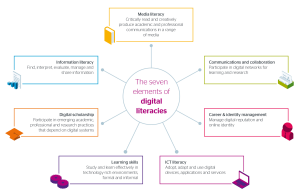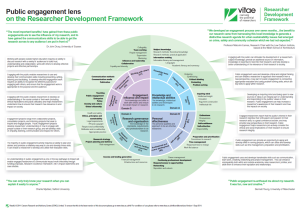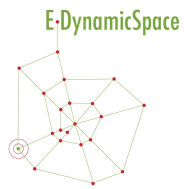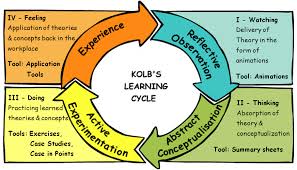I took part of Jisc’s “digital leadership” pilot programme, a two day residential in Bristol. Jisc is ‘prototyping’ a service for institutions that will allow institutions to diagnose themselves and their staff in relation to their digital capability in order to think about actions that the institution and their staff need to embrace to move towards being an agile digital university (If that is possible).
#jiscdiglead digital university defined? https://t.co/AsmAw8QvR1—
Lawrie Phipps (@Lawrie) October 22, 2015
Not forgetting that the ‘digital’ represents the medium, the vehicle by which the human project is partly mediated and delivered. It implies changes because the medium is influential but it is still the medium through which part of the experience is mediated.
When the printing press appeared -1442- and books started to be available for the public, people had to learn many new skills that we do not question anymore as for us reading is a default skill that we learn even before we go to school.
This video is a parody about how to use a book. Though the video refers more to the mechanical skills about how to operate the book, how to open and close it, how to read it, from the last page to the first or vice versa? there are also many intellectual skills like understanding how does the intonation of a story can be understood with out any voice telling the story. How to make sense of long chunks of texts or where is the pause to be made when reading, to mention just some of them. History says that people started to read out loud first and then slowly learned how to read in silent. I can imagine it was a process similar to this we are experiencing now with digital literacies. It is trying to understand how this new media operates, how can we make sense of the world using new tools that allow for new procedures to capture reality for example. I was imaging how would I design a workshop for printing press leaders (?).
The main idea of the service is to see what skills, knowledge and attitudes do people need in order to be able to bring change to their institution. The change this time is related to the digital experience. This change has to do with one of my interests in my dissertation, digital literacies and digital capability in students. The time plan for Jisc’s service can be seen clicking on the picture. I think the image is beautiful and it tells the story pretty well 🙂

The workshop:
Day 1 was mainly about the V+R (visitor and resident) approach developed by White and Lanclos (2014). The intention is to understand the motivations of people when engaging in different activities in the Web. Discover the logic behind peoples’ choices and actions. Making meaning of those actions we are interested to change or act upon. The way to do this is to map the tools you use and the platforms you visit in the Web and for what reasons (personal or institutional) and in which way you engage with them, in a visitor mode or a resident one. This idea was inspired by the Kevin Kelly’s Internet mapping project

My Visitor and Resident map
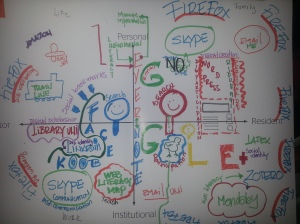
After this first exercise of mapping our ways of engagement we started to annotate the map using the six elements that imply digital capability:
- ICT proficiency
- Information, data and media literacy
- Digital creation, innovation and scholarship (Creating)
- Digital communication, collaboration and participation (Participating)
- Digital learning and PD (learning)
- Digital identity and well being (self-actualising)
What activities are we deploying and which of those capabilities are involved in them. Although we start with tools and platforms the focus is in the activities we are doing with those tools. But thinking about tools is a more concrete way to start the thinking process. Discussion and reflection where very useful to see in which ways we operate in the Web, how active we are and how much trace do we leave in the web. It was also interesting reflecting about what is a space in this virtual context. Is Twitter a space, a tool, a platform? Why do we visit that space, what are we looking for? Do we want to broadcast about our professional interest, engage in a professional network and share resources and ideas?
Day 2 was about the institutional side of the map. After reflecting about ones own practice we needed to move on to the institutional mode 🙂 How is our institution engaging in those platforms and tools and for what reason. Is the institution open or does it operate with many gateways to important spaces? Here the axis on the left side is related with open content and the one on the right hand side with open engagement, people with people instead of a more instrumental engagement looking for things, content and information. So the resident side of the map is related with the nature of the interactions in the institution. This was tricky for me as I am still quite new to the institution and I am still more of a PhD student I think. I had an exploration of what I thought Bath Spa looks like but I think it is nothing very accurate. Still needs more exploration and digging deeper into the institution. The discussion was very rich in any case. I saw the differences between institutions and how they have their own personality.
We had also parallel sessions to which we went. Digital storytelling and the use of social media for leaders in the institutions. Both of them interesting and food for thought. In particular I liked the storytelling one. The power of a story has always fascinated me. The presentation was very well thought and rich in good and eloquent images. I had to tell a story my self a week ago about my PhD in 3 minutes and that was a real challenge! Points to stress of the storytelling session:
Nancy Duarte has a TEDTalk about the structure of talks and stories as a powerful means to communicate ideas. With a story you get a physical reaction, a reaction for example, Steve Jobs enacted in his discourse. You can see the video for more details.
@cbthomson talked about the pixar story rules
The session on leaders and social media use was rich in content and discussion. Some time was spent on the ‘do and dont’s’ using social media from a leaders perspective. The value of an authentic leader but what is an authentic leader? What is her/his role when twitting from an institutional handle and so on.
The last session was about how to implement a change given a particular issue related with (in our case) assessment and progress in students. Very down to earth and to the point. It was about HOW TO implement a change, the practical side of it. Excellent session. Here the link to the document we edited in the session
We went home with lots of things to think about and in 4 weeks we are back to learn more!
The storify of the workshop
https://storify.com/Jisc/jisc-s-first-digital-leaders-programme-bristol-20-




